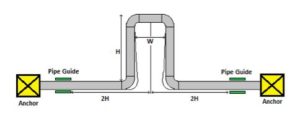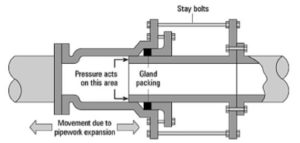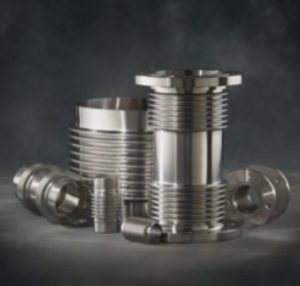Many types of expansion joints are used in industrial applications. Why are they necessary? As piping systems heat and cool, they experience changes in length caused by thermal expansion and contraction. The amount of this thermal expansion depends on the length of the piping run, the temperature differential, and the alloy of the pipe. Amazon Hose & Rubber Company can consultant with you to determine the best expansion joint for your requirements. Below are types of expansion joints:
Pipe Expansion Loops
Pipe expansion loops accommodate thermal movements in a piping system by installing sections of piping that run perpendicular to the piping system, as pictured below. Although these loops are semi-rigid, they do allow for some movement, thus reducing stress loads on the anchor points in the piping system.
Pipe expansion loops must be carefully designed and installed so that the pipe, elbows, and welded joints are able to withstand the loads exerted on them. While pipe loops do not require maintenance, they take up a lot of room in the piping system layout and therefore are most often used in outdoor piping arrangements. Increasing the length of the pipe legs (H) decreases the forces exerted on the piping system.
If thermal movements are required in more confined spaces, then some manufacturers make flexible loops, which use corrugated metal hose assemblies for each leg of the loop. These flexible loops are more compact than pipe loops, but require structural supports to prevent sagging, or special drains in low points to prevent condensate accumulation. These hose loops are typically used where seismic protection is required, and should be replaced after a seismic event. Additionally, a series of ball joints may be incorporated into the pipe loops to increase the offset capability, but these are prone to leakage if not maintained properly
If there is no room for an expansion loop, then a component capable of axial movement should be considered. Two products that can handle axial (compression/elongation) movements are slip joints and expansion joints.

Slip-type Joints
Slip-joints are installed in-line with the piping system, and compress as the pipe expands into them. This expansion is accommodated by a sleeve that slips into an outer shell. To prevent leakage through the slip joint, sealing materials are packed around the sleeve inside the shell.
Slip joints are very rugged components, and may be designed to allow for repairs without removing the joint. Slip joints are available in many different styles and configurations. However, they have several key limitations. First, slip joints can only accommodate axial movement (compression and elongation). Any lateral or angular movements can cause the inner sleeve to bind up inside the shell, limiting its ability to absorb thermal stress. Second, the packing material must be maintained and replaced regularly to prevent leakage. Too often, this maintenance is ignored, resulting in lost revenue from leaking steam or other media. Ball joints are similar to slip joints, except they are designed to handle angular movements. Ball joints also require regular maintenance of the packing material to prevent leakage. The need for a leak-free connection that can accommodate various movements has resulted in increased demand for expansion joints.
Bellows Type Expansion Joints
The most configurable types of expansion devices are metal expansion joints. They consist of one or more metal bellows, which are convoluted to provide flexibility.
A metal bellows expansion joint combines many of the benefits found in pipe loops and slip joints, while avoiding most of their shortcomings. Like pipe loops, properly designed expansion joints can be used to absorb thermal, mechanical, and/or seismic movements in any direction, and require no maintenance. Additionally, as with slip-type joints, expansion joints take up very little space in the piping system and can be designed to handle large axial movements. Unlike slip joints, expansion joints require no maintenance and can handle multiple movements. Expansion joints can be made from rubber, metal, or various polymers such as PTFE; although non-metallic expansion joints may cost less than metal expansion joints, they have limited temperature resistance and pressure-carrying capabilities, and can allow through-wall permeation of the media being conveyed. If the expansion joint is being installed outdoors, metal offers additional resistance to sunlight, ozone, temperature extremes and corrosive atmospheres (e.g. salt water) better than non-metallic components.
As you can see, there are various types of expansion devices to accommodate expansion and contraction in a properly designed piping system. Metal expansion joints offer many benefits and are increasingly relied upon to absorb these movements. Different styles, constructions, and hardware options can be used to customize the metal expansion joint for even the harshest of applications. Not sure where to start? Give us a call today and we’ll be happy to discuss how we can help.
To determine the best expansion joint for your needs, contact your Amazon Hose & Rubber Service Center at 407-843-8190 or check us out online at amazonhose.wpengine.com.
* Reposted from Hose Master 2016.